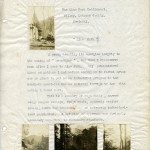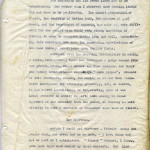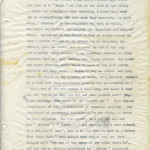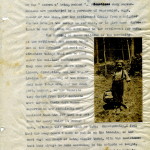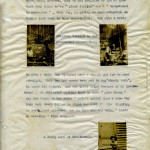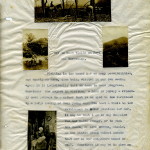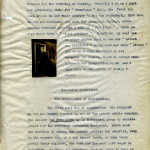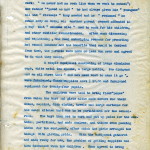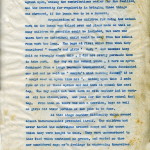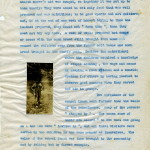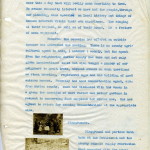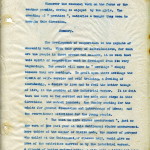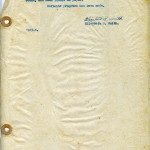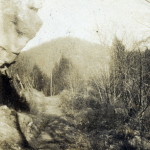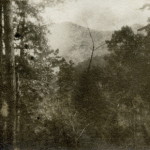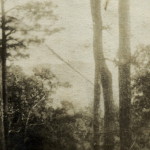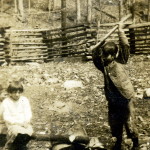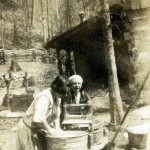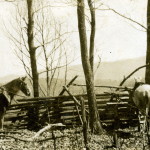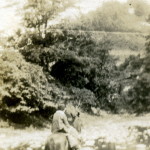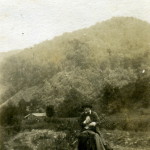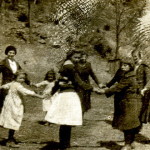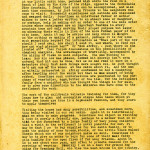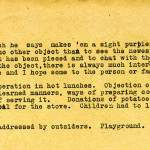Pine Mountain Settlement School
Series 09: BIOGRAPHY – Staff
Elizabeth G. Smith
Teacher, Coyle Branch School, Line Fork Settlement 1923 – 1924
Industrial Worker, Line Fork Settlement 1924 – 1927
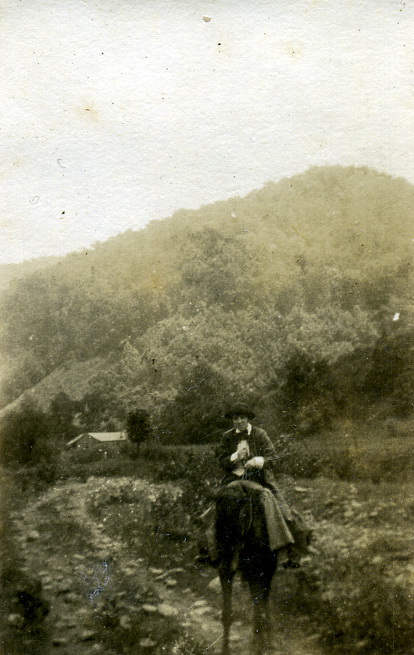
“Line Fork” by Elizabeth G. Smith, PMSS staff, 1923-1927. [lf_smith_006_img3.jpg]
ELIZABETH G. SMITH Staff
Teacher, Industrial Worker, 1923-1927
TAGS: Elizabeth G. Smith, Line Fork Settlement, industrial worker, Coyle Branch School, Harlan County KY, Letcher County KY, Bennetsville SC, industrial training, nursing, medicine, Katherine Pettit, recreation programs
Elizabeth G. Smith came to Line Fork Settlement as a teacher at Coil [Coyle] Branch School, but was then recruited to the position of Industrial Worker in February of 1924. The young woman from Oberlin College, Miss Rita Roeder, who originally filled the Industrial Worker position, left the position in October of 1923 to take up the position of community teacher and nurse and the position remained vacant for nearly four months.
Before Pine Mountain
Elizabeth came to Coil Branch School from Bennetsville, South Carolina, a small town in the northern region of that state. She had trained in South Carolina (though her early training is not yet discovered) and was soon caught up in the Settlement Movement. It is also not clear if she was an applicant for the Line Fork jobs or if she had been recruited by Miss Pettit and Miss de Long. Further exploration of the institutional record should reveal the answer to those questions.
ELIZABETH G. SMITH Staff: At Pine Mountain
When Elizabeth Smith took over the Industrial Worker position she tackled it with enthusiasm and, as evidenced by this account (Miss Smith’s narrative — see images and transcription below), some skill in making do. This position has been described by others as a “jack-of-all-trades” and Elizabeth confirms this in her narrative. Part cook, housekeeper, recreation specialist, and work-training specialist, the Industrial Worker played a vital role in the life and purpose of the rural settlement.
That she was a good fit for the jobs is seen in her longevity, her thorough reporting and sensitive approach to problem-solving, and community organization. She stayed at Line Fork as a staff worker from 1923 through 1927. It appears from the record that she was the single staff at the settlement from late 1924 to 1927.
GALLERY: “Line Fork” by Elizabeth G. Smith
- 001 Elizabeth G. Smith, author of “Line Fork.” [lf_smith_001_mod.jpg]
- 002 Elizabeth G. Smith, author of “Line Fork.” [lf_smith_002_mod.jpg]
- 003 Elizabeth G. Smith, author of “Line Fork.” [lf_smith_003_mod.jpg]
- 004 Elizabeth G. Smith, author of “Line Fork.” [lf_smith_004_mod.jpg]
- 005 Elizabeth G. Smith, author of “Line Fork.” [lf_smith_005_mod.jpg]
- 006 Elizabeth G. Smith, author of “Line Fork.” [lf_smith_006_mod.jpg]
- 007 Elizabeth G. Smith, author of “Line Fork.” [lf_smith_007_mod.jpg]
- 008 Elizabeth G. Smith, author of “Line Fork.” [lf_smith_008_mod.jpg]
- 009 Elizabeth G. Smith, author of “Line Fork.” [lf_smith_009_mod.jpg]
- 010 Elizabeth G. Smith, author of “Line Fork.” [lf_smith_010_mod.jpg]
- 011 Elizabeth G. Smith, author of “Line Fork.” [lf_smith_011_mod.jpg]
- 012 Elizabeth G. Smith, author of “Line Fork.” [lf_smith_012_mod.jpg]
- 013 Elizabeth G. Smith, author of “Line Fork.” [lf_smith_013_mod.jpg]
TRANSCRIPTION: “Line Fork” by Elizabeth G. Smith
THE LINE FORK SETTLEMENT
GILLEY, LETCHER COUNTY, KENTUCKY
1923 – 1924
“Line Fork”
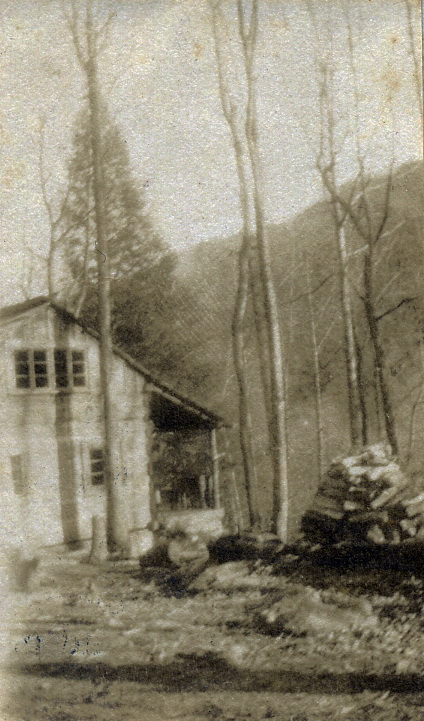 A creek, devoting its energies largely to the making of “moonshine,” was what I discovered soon after I came to Line Fork. Any preconceived ideas or notions I had before coming as to formal method or plans to put on an industrial program in the Southern Mountains became entirely foreign to the situation found here.
A creek, devoting its energies largely to the making of “moonshine,” was what I discovered soon after I came to Line Fork. Any preconceived ideas or notions I had before coming as to formal method or plans to put on an industrial program in the Southern Mountains became entirely foreign to the situation found here.
This is a country of high hills, narrow wedge shaped valleys, rough roads, sparsely settled creeks, forks and branches, and an intensely individualized population. A new line of approach was obviously necessary according to customary standards.
The community and its needs first had to be ascertained. And rather soon I observed that farming itself did not seem to be profitable. The almost perpendicular fields, the scarcity of bottom land, the absence of good roads, and the remoteness of markets, [have] made it very difficult for the people with their scanty knowledge of farming to make an adequate living from the soil. Accentuating this condition has been the increasing sub-division of the land through inheritance into smaller farms.
Parallel with the existing difficulties in making a living from farming there has developed a large demand from the growing mining camps across the Pine Mountain for their one easily transportable commodity — “corn liquor.” Because of this increasing demand, the making of it has been stimulated throughout the community generally, and, of course, it has solved immediately, if temporarily, some of the local problems of family support; this making it quite apparent to the onlooker that the making of whiskey in this vicinity is more a question of economies than that of ethics.
The Approach
Before I could get anywhere, friends among the people along the creek had to be made — a task which was not as hard as I anticipated. “Former” workers, I fancy, have made this road easier by their contacts. The Line Forkers, however, are very responsive to friendliness.
At our little cabin home, perched high above the road on a “bench” of land on the side of the ridge, opposite the formidable Pine Mountain, I found that much can be accomplished, and also much time consumed, by just being “friends” to the neighbors who come to visit. Household experiences and methods are discussed and “swapped” daily. Sometimes an unlettered father or mother wishes to have a letter written to an absent son or daughter, or, perhaps, help in making out an order to one of the mail order houses whose catalog is an important feature in every mountain home not only serving its proper purpose but later its pages adorning their walls in lieu of the more formal paper of the city home. Again it may be advice and help which is sought on the cutting or making of a garment, perhaps it is for some such surprising request for informaton as; “What part of the cow should I send away, how shall I send it, and where to find out how and what ‘pizened’ her?” or “… now Africey, — just where is she located at?” Then follow discussions on the possibilities of chemical analysis, the advantages of traveling, accompanied by the airing of views on said subjects. The man wishing to learn how his cow was “pizened,” ” ‘lowed hit shorely don’t seem naterel that hit can be done,” but as he had read it once in a detective story that “sech things were sought out,” he just thought he’d “ask one of the women at the cabin about it.” And the man so vitally interested in “Africey” confessed he had a “hankering after traveling about the world,” but he was “skeert o’ being robbed.” Sometimes such conversations are punctuated by a purchase of vegetables, eggs, butter or the like, for the settlement family from a neighbor who has brought the thing in for sale, or to give some direction to the children who have come to the settlement for work.
The working of these children of the community at the settlement has seemed to me one of the soundest and most constructive things that can be done under the existing conditions. They come 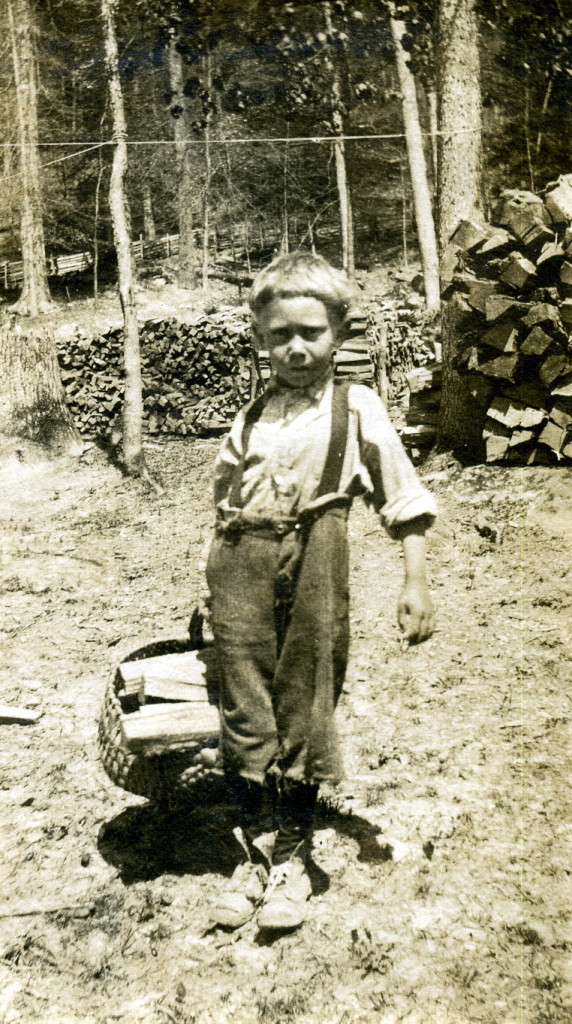 from homes where cleanliness, discipline, and the organization and planning of the necessary home things are, for the most part, unknown, so the benefits they derive from their contacts here through their work under supervision are
from homes where cleanliness, discipline, and the organization and planning of the necessary home things are, for the most part, unknown, so the benefits they derive from their contacts here through their work under supervision are
strikingly more manifold than the few they may get from the money which it brings them, although this means much to them. Consequently, I feel that the many hours I have to put in on the teaching of the best ways and means of doing simple tasks, with the insistence that they always be done according to the methods as taught are well spent, for often we hear how an attempt is made to carry out some of these practices in their own homes. Sometimes, however, they do not hesitate to let us know that they think we’re “plumb foolish” and a “botherment to ourselves,” they say, in giving so much attention to things that seem to them unessential.
Children working on the Settlement reservation
A Young Lord of Creation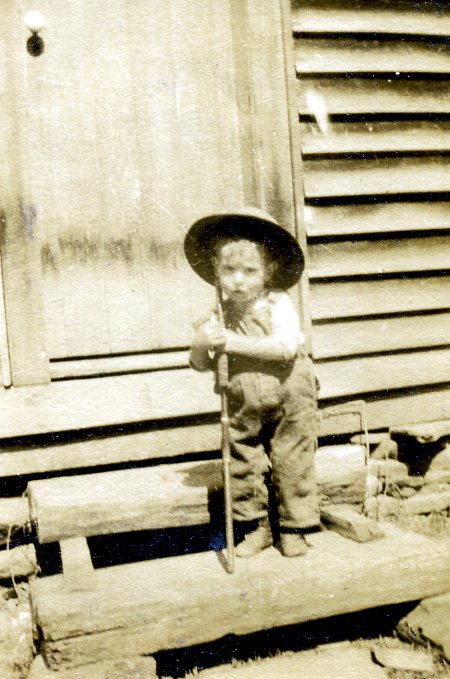
One time I tried to keep a small boy diligent over a single job for an hour straight. This boy had never been put to work on any “steady work,” to quote his father, and was quite irked because of my insistence. He reflected audibly that he knew “pine blank” why the women at the cabin “hadn’t gotten them a man — why they work every fellow in sight too hard!” His dignity, no doubt, was offended — Men in this country being “lords of creation” from babyhood.
Visiting in the homes has many possibilities, and sometimes more, than being visited in our own cabin. Again it is individually that we seem to make progress. Sometimes the object in visiting a home is purely a friendly one; perhaps to another that is so tied to the farmstead by a large family of very young children that a visit to the settlement is never possible for her. It may be that I go to buy supplies for the cabin family, or to push the making of some brooms, stools, or the little black walnut chests that one of our neighbors makes, as well. Sometimes it may be to give an order to boys for some of their neat “fatty pine” bundles for the fires of far away friends.
Again it is to see about some yarn, and often to promote reasons for reviving of weaving.
- [lf_smith_006_img3.jpg]
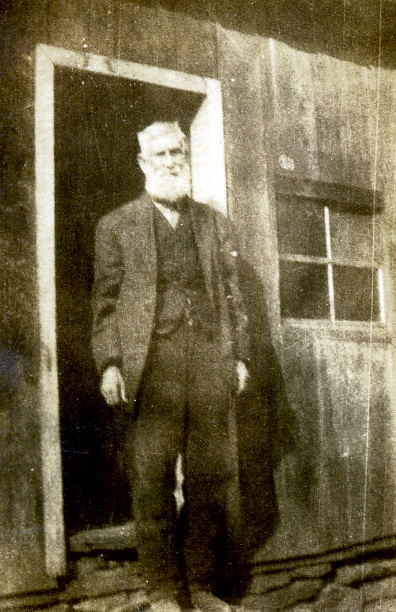 Possibly I am on a hunt for groundhog skins for “Grand-pap” Hall, who “ties the best brooms in the whole country” ; but who reluctantly ties them in the old fashioned way with the groundhog strings, since someone recently gave him a ball of “red twine,” which he says makes them a “might prettier.”
Possibly I am on a hunt for groundhog skins for “Grand-pap” Hall, who “ties the best brooms in the whole country” ; but who reluctantly ties them in the old fashioned way with the groundhog strings, since someone recently gave him a ball of “red twine,” which he says makes them a “might prettier.”
Sometimes my call has no other object than to see the “newest and prettiest” quilt that has been “pieced” and to chat with the maker of it! Whatever the object there is always much interest and instruction to me and I hope some to the person or family I visit.
Community Activities
The Development of Cooperation
The first real bit of cooperation was realized in the hot school lunches in one of the nearer public schools. Ten dollars had been given by an interested group of outside people for the necessary permanent equipment. First came the question of making the parent realize the benefits, even in the vaguest way, of a hot school lunch, so they would permit their children, who were for the most part eager to cooperate, to bring the necessary food supplies to make it a going proposition. Some of the objections interposed were: “We never had no sech like when we went to school” ; one father ” ‘lowed as how” he had always given his “younguns” all the “victuals” they needed and he “reckoned” he could keep on doing so; another parent seemed offended in a way that “someone else” had to cook for his children, and other similar remonstrances. After much discussing and explaining, the real underlying reasons for promoting hot school lunches and the benefits that could be derived from them, the parents were more or less won over and agreed to do what they could.
[S]imple equipment consisting of large aluminium cups, white metal tea spoons, a large kettle, two dishpans, and an oil stove that “did not need wood to make it go,” were furnished equipment for twenty-four pupils.
The children were told to bring flour “pokes” from which the boys and girls alike made covers for their desks, napkins, dishcloths, towels, and large curtains for the small kitchen that was to be partitioned off the school-room. The boys then set to work and put up poles for the curtains, [and] partitions, and made shelves and tables from packing boxes for the equipment, after which the girls arranged the things with glowing pride. With the equipment gathered and made ready for use, the problem of getting supplies was then discussed with the children. Some agreed to bring potatoes, some milk, some sugar, and some coal oil for the “wonderful new stove.” A plan for alternating was also agreed upon, making the contributions easier for the families, and the necessity for regularity in bringing these things was stressed, if the lunch was to be a success.
Organization of the children for doing the actual work on the lunch was talked over and plans made so that as many children as possible could be included, but care was taken that no individual child would be away from what they considered “women’s and girl’s work” and because they felt so strongly about this, I did not overly persuade them to take part. One day at the school lunch, I wore an apron fashioned from a large bandanna handerkchief, which fascinated one lad and he said he “wouldn’t mind dishes” if he “could wear an apron like hit.” Acting upon this I made five or six of these aprons and had them at school the next day. The boy couldn’t back down so with another lad he washed all the dishes, pots, and pans for the entire school that day. From then on there was not a question; boys as well as girls did their portion of the jobs to be done.
At this stage another difficulty which seemed almost insurmountable presented itself. The children had never tasted the nutritious creamed soups and the cocoa which they were taught to make. They were unaccustomed to this food which contained no grease, and wasted no time nor considered anyone’s feelings in expressing themselves very frankly how they felt. How to get them to “down the stuff,” as they said, was then the question. The public health nurse’s aid was sought, so together it was put up to them thusly: They were asked to eat only food that was well prepared and was nutritious; to be good sports and not quitters; and, if at the end of one week of honest trying to like the lunches prepared, they could not “down them,” then they need not try any more. A week of well-prepared hot soups or cocoa with the corn bread still brought from home, weaned the children away from the former cold beans and corn bread brought in the family pail. Besides the nutritional value the children acquired a knowledge of simple cooking, the ways and means of keeping a neat kitchen and a consideration for others by having learned to observe good manners when they served and ate in groups.
The influence of the school lunch went further than the walls of the school house. Many of the parents “stopped by.” The women came of their own accord “to see what was going on”: the men were “invited in,” and all these visitors were served by the children in the same manner as themselves. The value of the school lunch was thus brought to the community not by talking but by direct example.
Sunday Schools
We have tried to make our Sunday Schools more than formal Sunday Schools. Sunday is the only day that the people are entirely free from their work, so we endeavor to make this a day that will really mean something to them. To awaken community interest we have had the people, through our planning, make speeches on local history and things of common interest within their own experience. The singing of their ballads, as well as of their hymns, is a feature of much enjoyment.
Whenever the occasion has offered, an outside speaker has addressed the meeting. There is no county agricultural agent in this [Letcher] county, but the agent from the neighboring Harlan County has come and not only given inspirational talks but also taught a number of our neighbors to graft trees, advised others on such questions as livestock breeding, registered eggs, and the building of good chicken houses. Recently the Home Demonstration Agent, also from Harlan County, came and discussed with the women in a group the question of more varied and better gardens in respect to conserving food supplies for winter use. She has agreed to return for canning demonstrations at the appropriate time.
Playgrounds
Playground and parties both at the Settlement and the nearby schools supply recreation that competes with the usual shooting matches, drinking, card playing, etc.
Sewing
Whenever the seasonal work on the farms or the weather permits, sewing is enjoyed by the girls. The creating of “pretties,” satisfies a hunger they seem to have in this direction.
Summary
The development of cooperation is the keynote of community work. With this group of individualists, for such are the people in these creeks and hollows, it is seen that this spirit of cooperation must be developed from its very beginnings. The people will come to “meetings” simply because they are meetings. To graft upon these meetings the spirit of self-service and self-training, a feeling of comradeship, a desire to live and to feel the better things of life, is the problem of the Industrial Worker. It is felt that the work so far carried out has made some steps in this direction: the school; the Sunday meeting for the adults for general discussion and interchange of ideas; and the recreational activities for the young people.
“The best in life eludes measurement,” just as the work of the past year at this settlement eludes measurement. Mere tables of the number of visits made, the number of persons who called at the Settlement, or classes held, would give no idea of the activities carried on by the Industrial Worker. A glimpse of better understanding, a life made a little brighter, or a child taught to see more clearly, are the things that count, but mean little on paper.
Definite progress has been made.
[signed] Elizabeth G. Smith
1923-24
Report Summary for Work at Line Fork 1923-24 [?]
- Elizabeth Smith. Line Fork Summary Report, 1924 [?] p. 01
- Elizabeth Smith. Line Fork Summary Report, 1924 [?] p. 02
TRANSCRIPTION:
Extracts from report on year’s work, Miss [Elizabeth] Smith [1927 ?]
At our little cabin home, perched high above the road on a bench of land on the side of the ridge, opposite the formidable Pine Mountain I found that much can be accomplished, and also much time consumer, by just being friends to the neighbors who come to visit. Household experiences and methods are discussed and swapped daily. Sometimes an unlettered father or mother wishes to have a letter written to an absent son or daughter, or perhaps help in making out an order to one of the mail order houses whose catalogues [sic] are an important feature in every mountain home not only serving their proper purpose but later on adorning their walls in lieu of the more formal paper of the city home. Again it may be advice and help which is sought on the cutting or making of a garment, perhaps it is for some much surprising request for information as “What part of the cow should I sent away. How shall I send it, and where, to find out how and what pizened her?” Or “Now Africy, — just where is she located at?” Then follow discussions on the possibilities of chemical analysis, the advantages of travelling, accompanied by the airing of views on said subjects. The man wishing to learn how his cow was pizened, lowed hit shorely don’t seem natural that hit can be done, but as he had read it once in a detective story that such things were sought out, he just thought he’d ask one of the women at the cabin about it. And the man so vitally interestwed in Africy confessed he had a hankering after traveling about the world but that he was skeert of being robbed. Sometimes such conversations are punctuated by the purchase of vegetables, eggs, butter or the like, for the settlement family from a neighbor who has brought the things in for sale, or to give some directions to the children who have come to the settlement for work.
The work of the children is valuable training for them, for they learn how to plan and accomplish simple home tasks which at their own homes are done in a haphazard fashion, and they learn to apply themselves.
Visiting the homes has many possibilities, and sometimes more than being visited in our own cabin. Again it is individually that we seem to make progress. Sometimes the object in visiting a home is purely a friendly one, perhaps to a mother that is so tied to the farmstead by a large family of very young children that a visit to the settlement is never possible for her. It may be that I go to buy supplies for the cabin family, or to push the making of some brooms, stools, or the little black walnut chests which one of our neighbors makes so well. Sometimes it may be to give an order to boys for some of their neat fatty pine bundles for the open fires of far away friends. Again it is to see about some yarn, and often to promote reasons for the reviving of weaving. Possibly I am on a hunt for ground hog skins for Grandpap Hall; who ties the best brooms in the country, who reluctantly ties them in the old fashioned way with the groundhog strings, since someone recently gave him a ball of red twine which he says makes ’em a sight purtier. Sometimes my call has no other object that to see the newest and prettiest quilt that has been pieced and to chat with the maker of it. Whatever the object, there is always much interest and instruction to me and I hope some to the person or family I visit.
First cooperation is hot lunches. Objection of the parents. Children learned manners, ways of preparing cocoa and soup, methods of serving it. Donations of potatoes, milk, sugar and coal oil for the stove. Children had to learn to like it too.
Meetings addressed by outsiders. Playground.
See Also LINE FORK SETTLEMENT
|
Title |
Elizabeth G. Smith |
|
Identifier |
Permalink: https://pinemountainsettlement.net/?page_id=4439 |
|
Creator |
Pine Mountain Settlement School, Pine Mountain, KY |
|
Alt. Creator |
Ann Angel Eberhardt ; Helen Hayes Wykle ; |
|
Subject Keyword |
Elizabeth G. Smith ; Pine Mountain Settlement School ; Pine Mountain, KY ; Industrial Workers ; Line Fork Settlement ; education ; health education ; recreation ; food ; food preparation ; health ; farming ; farms ; Coil (Coyle) Branch School ; Oberlin College ; Rita Roeder ; recreation specialists ; work-training specialists ; Settlement Movement ; Miss Pettit ; Miss de Long ; Line Fork Creek ; moonshine ; mining camps ; corn liquor ; broom-making ; quilting ; school lunches ; students ; nutrition ; Sunday Schools ; ballads ; hymns ; agricultural agents ; home demonstration agents ; playgrounds ; sewing ; kitchens ; community organization ; industrial training ; job training ; weaving ; child welfare ; Bennetsville, SC ; Gilley, KY ; Letcher County, KY ; Harlan County, KY ; |
|
Subject LCSH |
Smith, Elizabeth G., — Dec 22, 1900 – Feb. 1973. [?] |
|
Date |
2013-12-08 hw |
|
Publisher |
Pine Mountain Settlement School, Pine Mountain, KY |
|
Contributor |
n/a |
|
Type |
Collections ; text ; image ; |
|
Format |
Original and copies of documents and correspondence in file folders in filing cabinet |
|
Source |
Series 9: Biography – Staff/Personnel |
|
Language |
English |
|
Relation |
Is related to: Pine Mountain Settlement School Collections, Series 9: Biography – Staff/Personnel and Series 14: Medical — Line Fork Settlement |
|
Coverage Temporal |
1923 – 1927 |
|
Coverage Spatial |
Pine Mountain, KY ; Harlan County, KY ; Letcher County, KY ; Bennetsville, SC; Oberlin, OH ; |
|
Rights |
Any display, publication, or public use must credit the Pine Mountain Settlement School. Copyright retained by the creators of certain items in the collection, or their descendants, as stipulated by United States copyright law. |
|
Donor |
Elizabeth G. Smith |
|
Description |
A personal autobiographical narrative about Elizabeth G. Smith and her work at the Line Fork Settlement from 1923 to 1927 as a rural school teacher Coil [Coyle] Branch and as an industrial worker with the Line Fork community. |
|
Acquisition |
n/a |
|
Citation |
Smith, Elizabeth G. “Line Fork Settlement. Gilley, Letcher County, Kentucky.” Narrative. [Series 9 and Series 14]. Pine Mountain Settlement School Institutional Papers, Pine Mountain, KY. (1923 – 1924). Archival material. |
|
Processed By |
Helen Hayes Wykle ; Ann Angel Eberhardt ; |
|
Last Updated |
2013-12-07 hhw; 2018-09-30 hhw; 2021-03-02 aae ; |
|
Bibliography |

